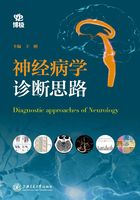
第三节 脑血管病诊断思路小结
脑血管病是严重危害人类健康和生命的常见病、多发病,其病因、发病机制、病理类型、临床征象较为复杂。在进行诊断时,我们首先要详细询问患者病史及临床症状,进行详细的体格检查,将体征与病史结合分析,明确疾病的解剖定位并提出进一步的推测。合理利用实验室及多模态影像学检查手段,准确判定脑血管病的性质,明确责任血管以及颅内灌注、缺血半暗带情况、侧支循环等,合理制订急性期的诊疗方案,并进一步对疾病的病因、机制进行分型诊断,对疾病进行分层管理,为长期二级预防策略的制订提供准确的依据。
(张莉莉 唐春花)
思考题
1.脑血管病的分类有哪些?
2.脑血管病的诊断步骤有哪些?
3.脑血管的影像评估手段有哪些?
4.脑出血后预示血肿扩大的特征性影像学表现有哪些?
参考文献
[1]KAMALIAN S, LEV MH. Stroke imaging [J]. Radiol Clin North Am, 2019,57(4):717-732.
[2]VILELA P, ROWLEY HA. Brain ischemia: CT and MRI techniques in acute ischemic stroke [J]. Eur J Radiol, 2017,96: 162-172.
[3]MAINALI S, WAHBA M, ELIJOVICH L. Detection of early ischemic changes in noncontrast CT head improved with "stroke windows" [J]. ISRN Neurosci, 2014,2014:654980.
[4]LIM J, MAGARIK JA, FROEHLER MT. The CT-defined hyperdense arterial sign as a marker for acute intracerebral large vessel occlusion [J]. J Neuroimaging, 2018,28(2):212-216.
[5]SCHRÖDER J, THOMALLA G. A critical review of Alberta stroke program early CT score for evaluation of acute stroke imaging [J]. Front Neurol, 2017,7:245.
[6]KHATIBI K, NOUR M, TATESHIMA S, et al. Posterior circulation thrombectomy-pc-ASPECT score applied to preintervention magnetic resonance imaging can accurately predict functional outcome [J]. World Neurosurg, 2019,129:e566-e571.
[7]SHAKER H, KHAN M, MULDERINK T, et al. The role of CT perfusion in defining the clinically relevant core infarction to guide thrombectomy selection in patients with acute stroke [J]. J Neuroimaging, 2019,29(3):331-334.
[8]MEDINA RM, MILLAN VM, ZAPATA AE, et al. Intravenous thrombolysis guided by perfusion CT with alteplase in >4.5 hours from stroke onset [J]. Cerebrovasc Dis, 2020,49(3):328-333.
[9]NOGUEIRA RG, JADHAV AP, HAUSSEN DC, et al. Thrombectomy 6 to 24 hours after stroke with a mismatch between deficit and infarct [J]. N Engl J Med, 2018,378(1):11-21.
[10]ALBERS GW, MARKS MP, KEMP S, et al. Thrombectomy for stroke at 6 to 16 hours with selection by perfusion imaging [J]. N Engl J Med, 2018,378(8):708-718.
[11]POWERS WJ, RABINSTEIN AA, ACKERSON T, et al. Guidelines for the early management of patients with acute ischemic stroke: 2019 update to the 2018 guidelines for the early management of acute ischemic stroke: a guideline for healthcare professionals from the American Heart Association/American Stroke Association [J]. Stroke, 2019,50(12): e344-e418.
[12]中华医学会神经病学分会,中华医学会神经病学分会脑血管病学组.中国脑血管病影像应用指南2019 [J].中华神经科杂志,2020,53(4):250-268.
[13]CALDERON VJ, KASTURIARACHI BM, LIN E, et al. Review of the mobile stroke unit experience worldwide [J]. Interv Neurol, 2018,7:347-358.
[14]BOUSLAMA M, HAUSSEN DC, GROSSBERG JA, et al. Flat-panel detector CT assessment in stroke to reduce times to intra-arterial treatment: a study of multiphase computed tomography angiography in the angiography suite to bypass conventional imaging [J]. Int J Stroke, 2021,16(1): 63-72.
[15]SUNDARAM VK, GOLDSTEIN J, Wheelwright D, et al. Automated ASPECTS in acute ischemic stroke: a comparative analysis with CT perfusion [J]. Am J Neuroradiol, 2019,40(12): 2033-2038.
[16]DUFFIS EJ, JETHWA P, GUPTA G, et al. Accuracy of computed tomographic angiography compared to digital subtraction angiography in the diagnosis of intracranial stenosis and its impact on clinical decision-making [J]. J Stroke Cerebrovasc Dis, 2013,22(7):1013-1017.
[17]BARADARAN H, GUPTA A. Carotid vessel wall imaging on CTA [J]. Am J Neuroradiol, 2020,41(3):380-386.
[18]GRUNWALD IQ, KULIKOVSKI J, REITH W, et al. Collateral automation for triage in stroke: evaluating automated scoring of collaterals in acute stroke on computed tomography scans [J]. Cerebrovasc Dis, 2019,47(5-6): 217-222.
[19]BASH S, VILLABLANCA JP, JAHAN R, et al. Intracranial vascular stenosis and occlusive disease: evaluation with CT angiography, MR angiography, and digital subtraction angiography [J]. Am J Neuroradiol, 2005,26(5): 1012-1021.
[20]YOUNG CC, BONOW RH, BARROS G, et al. Magnetic resonance vessel wall imaging in cerebrovascular diseases [J]. Neurosurg Focus, 2019,47(6):E4.
[21]LI Q, ZHANG G, XIONG X, et al. Black hole sign: novel imaging marker that predicts hematoma growth in patients with intracerebral hemorrhage [J]. Stroke, 2016,47(7): 1777-1781.
[22]LI Q, ZHANG G, HUANG YJ, et al. Blend sign on computed tomography: novel and reliable predictor for early hematoma growth in patients with intracerebral hemorrhage [J]. Stroke, 2015,46(8): 2119-2123.
附表 中国脑血管病的分类诊断要点

续表

此表参考《中国脑血管病分类2015》及《中国各类主要脑血管病诊断要点2019》